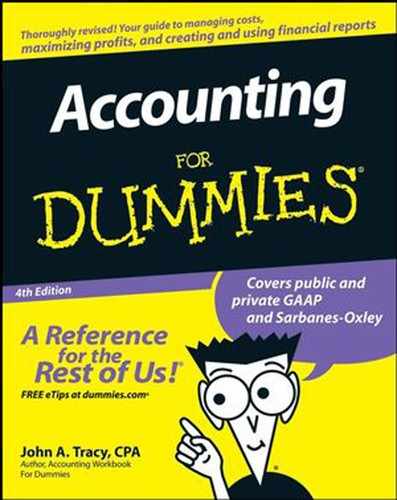3.4. Double-Entry Accounting for Single-Entry Folks
Businesses and nonprofit entities use double-entry accounting. But I've never met an individual who uses double-entry accounting in personal bookkeeping. Instead, individuals use single-entry accounting. For example, when you write a check to make a payment on your credit card balance, you undoubtedly make an entry in your checkbook to decrease your bank balance. And that's it. You make just one entry — to decrease your checking account balance. It wouldn't occur to you to make a second, companion entry to decrease your credit card liability balance. Why? Because you don't keep a liability account for what you owe on your credit card. You depend on the credit card company to make an entry to decrease your balance.
NOTE
Businesses and nonprofit entities have to keep track of their liabilities as well as their assets. And they have to keep track of all sources of their assets. (Some part of their total assets comes from money invested by their owners, for example.) When a business writes a check to pay one of its liabilities, it makes a two-sided (or double) entry — one to decrease its cash balance and the second to decrease the liability. This is double-entry accounting in action. Double-entry does not mean a transaction is recorded twice; it means both sides of the transaction are recorded at the same time.
|
The accounting equation is a very condensed version of the balance sheet. The balance sheet is the financial statement that summarizes a business's assets on the one side and its liabilities plus its owners' equity on the other side. Liabilities and owners' equity are the sources of its assets. Each source has different claims on the assets, which I explain in Chapter 5.
One main function of the bookkeeping/accounting system is to record all transactions of a business — every single last one. If you look at transactions through the lens of the accounting equation, there is a beautiful symmetry in transactions (well, beautiful to accountants at least). All transactions have a natural balance. The sum of financial effects on one side of a transaction equals the sum of financial effects on the other side.
Suppose a business buys a new delivery truck for $65,000 and pays by check. The truck asset account increases by the $65,000 cost of the truck, and cash decreases $65,000. Here's another example: A company borrows $2 million from its bank. Its cash increases $2 million, and the liability for its note payable to the bank increases the same amount.
Just one more example: Suppose a business suffers a loss from a tornado because some of its assets were not insured (dumb!). The assets destroyed by the tornado are written off (decreased to zero balances), and the amount of the loss decreases owners' equity the same amount. The loss works its way through the income statement but ends up as a decrease in owners' equity.
| Assets | = | Liabilities | + | Owners' Equity |
| + Debit | + Credit | + Credit | ||
| − Credit | − Debit | − Debit |
An increase in an asset is tagged as a debit; an increase in a liability or owners' equity account is tagged as a credit. Decreases are just the reverse. Following this scheme, the total of debits must equal the total of credits in recording every transaction. In brief: Debits have to equal credits. Isn't that clever? Well, the main point is that the method works. Debits and credits have been used for centuries. (A book published in 1494 described how business traders and merchants of the day used debits and credits in their bookkeeping.)
Note: Sales revenue and expense accounts also follow debit and credit rules. Revenue increases owners' equity (thus is a credit), and an expense decreases owners' equity (thus is a debit).
The balance in an account at a point in time equals the increases less the decreases recorded in the account. Following the rules of debits and credits, asset accounts have debit balances, and liabilities and owners' equity accounts have credit balances. (Yes, a balance sheet account can have a wrong-way balance in unusual situations, such as cash having a credit balance because the business has written more checks than it has in its checking account.) The total of accounts with debit balances should equal the total of accounts with credit balances. When the total of debit balance accounts equals the total of credit balance accounts, the books are in balance.
|

